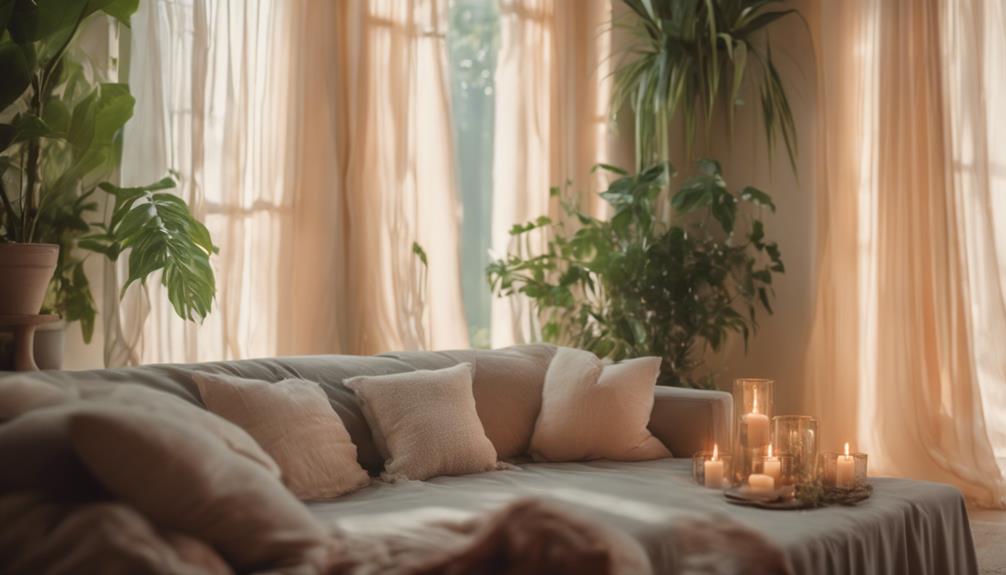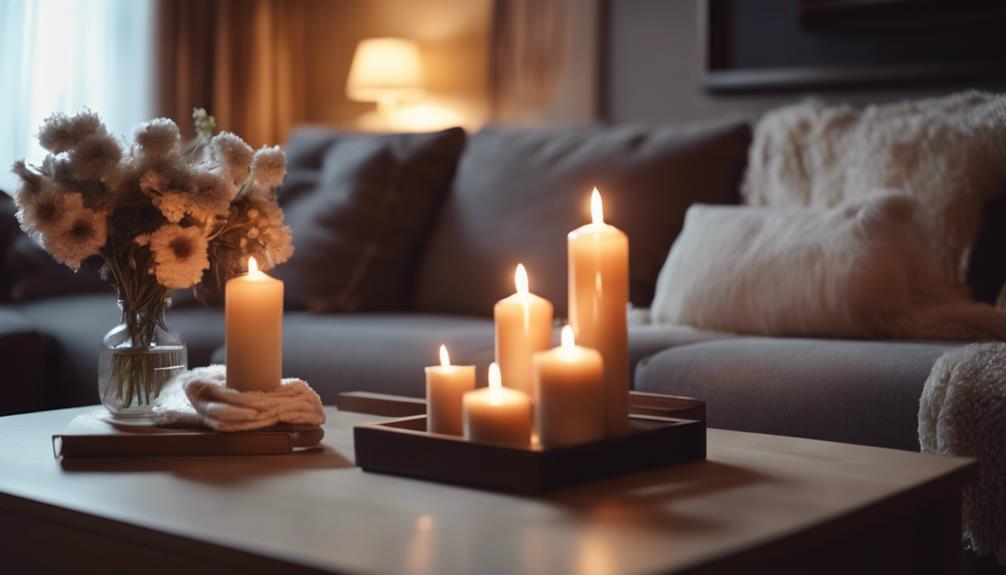Creating a relaxing and rejuvenating home sanctuary is all about personalization and natural elements. Start by letting in plenty of natural light and adding houseplants to boost your mood. Designate a cozy corner for meditation or mindfulness, and surround yourself with soothing scents from essential oils. Use soft lighting, like dimmable lamps or candles, to create a calm atmosphere. Regularly declutter your space to keep stress at bay, and update your decor to reflect your evolving tastes. Follow these transformative tips to craft your tranquil oasis, and you'll discover even more ways to enhance your sanctuary experience.
Key Takeaways
- Incorporate natural elements like plants and water features to enhance tranquility and air quality in your sanctuary.
- Optimize lighting with soft, warm hues and dimmable options to create a calming ambiance.
- Personalize your space with meaningful decor, cherished photos, and inspiring quotes for a comforting atmosphere.
- Establish regular relaxation rituals, such as meditation or deep breathing, to foster mindfulness and stress relief.
Understanding Home Sanctuaries
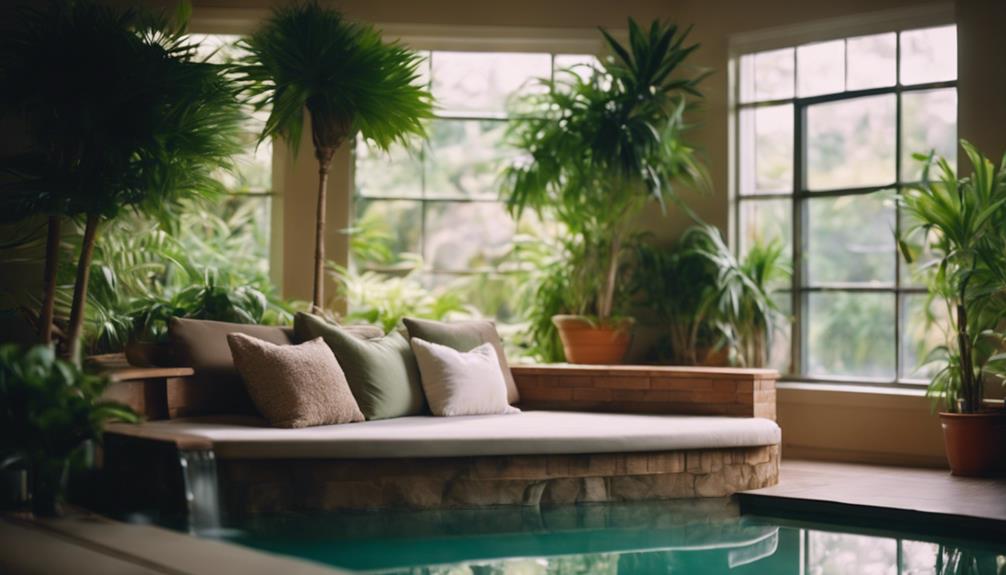
A home sanctuary is your personal haven, crafted to offer comfort and tranquility while reflecting your unique style and emotional needs. It's important to understand that this space plays a significant role in your overall well-being and mental health.
To create a space that feels like a refuge, focus on elements that promote relaxation and mindfulness. Incorporating natural light is essential; it not only brightens your environment but also enhances your mood and energy levels. You might consider large windows or soft, sheer curtains to allow sunlight to filter in gently.
Adding plants can further elevate your sanctuary, as they've been linked to reduced stress and improved mental clarity. Make sure your sanctuary remains quiet and private, allowing you to disconnect from external stressors.
Pay attention to details like meaningful décor and personal items that resonate with you emotionally. Regular maintenance and decluttering are crucial to preserve that calming atmosphere, ensuring your home sanctuary remains an inviting space for reflection and self-care.
Personalizing Your Sanctuary Space
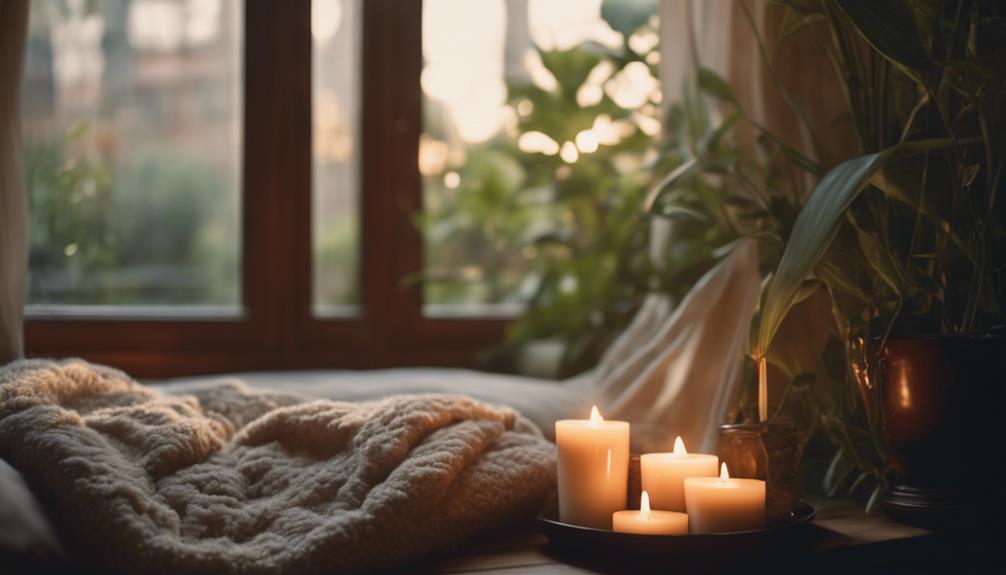
To truly personalize your sanctuary space, start by defining your vision and what brings you comfort.
Incorporate personal touches that reflect your personality, like cherished photos or favorite colors.
Remember to update your sanctuary regularly to keep it fresh and aligned with your evolving tastes.
Define Your Sanctuary Vision
Journaling your thoughts can help you uncover what truly makes a sanctuary feel comforting and personalized for you. Start by identifying the elements that evoke relaxation and emotional well-being. Think about what you need to create a sanctuary that feels cozy and inviting. Consider incorporating natural sunlight, as it brightens your space and uplifts your mood.
Next, assess your current home environment. Pinpoint areas that induce stress and recognize what changes can help you feel comfortable. This might involve rethinking furniture layout, choosing calming color schemes, or decluttering. Reflect on your individual tastes, and use decor elements that resonate with you—whether that's personal items, photographs, or meaningful quotes.
To keep your personal sanctuary aligned with your evolving preferences, revisit your vision regularly. Use design platforms like Pinterest for inspiration, focusing on cozy elements and layouts that appeal to you.
Incorporate Personal Touches
Incorporating personal touches into your sanctuary space transforms it from just a room into a reflection of who you are, enhancing both comfort and emotional connection.
Start by displaying meaningful artwork that resonates with you; this creates a soothing atmosphere and adds character to your space. Personal items, like heirlooms or souvenirs from your travels, can evoke positive memories and make your sanctuary feel like home.
Consider creating a cozy corner with your favorite chair and a soft blanket, where you can unwind and practice mindfulness. Surround this area with items that inspire you, such as meaningful quotes or affirmations—these can reinforce a positive mindset during your relaxation time.
Tailor the decor and layout according to your preferences, ensuring every element, from color schemes to furniture arrangements, brings you tranquility.
Update Regularly for Freshness
Updating your sanctuary space regularly keeps it feeling fresh and inspiring, allowing you to enjoy a renewed sense of tranquility. By making small changes, you can easily transform your environment into a more inviting retreat. Here are some tips to help you update regularly for freshness:
Incorporate seasonal elements: Swap out throw pillows, artwork, or decorative pieces to reflect the current season.
Personalize your space: Add new photographs, meaningful quotes, or items that tell your story, reinforcing the comforting purpose of your sanctuary.
Engage in small DIY projects: Create your own decor or upcycle old items to refresh your space while fostering a sense of accomplishment.
Set a schedule for updates: Plan bi-annual or quarterly refreshes to maintain a sense of novelty without cluttering your sanctuary.
Incorporating Natural Elements
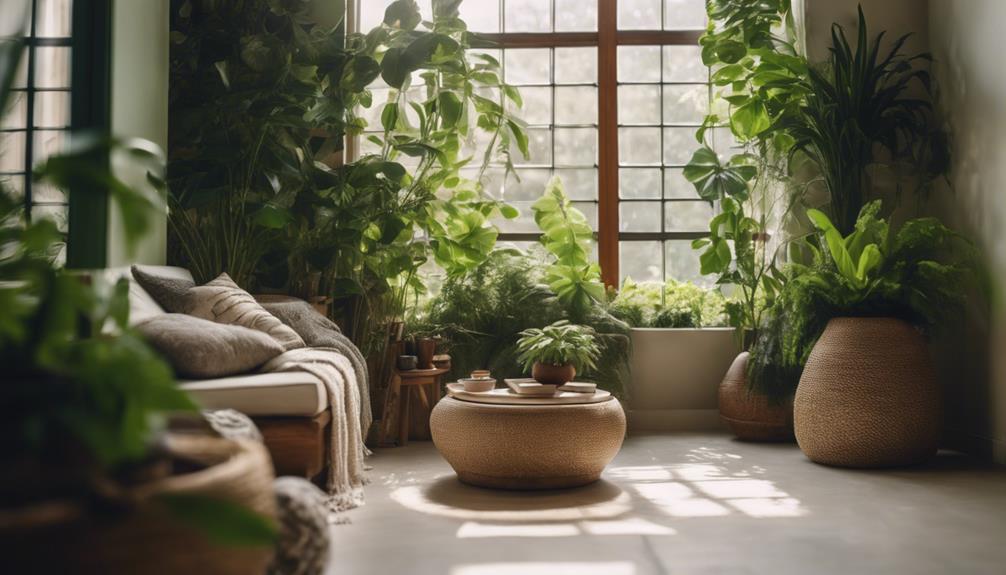
Bringing natural elements into your home can transform it into a serene sanctuary that nurtures both your mind and body. Start by incorporating potted plants, as they not only enhance air quality but also reduce stress levels. Surrounding yourself with greenery fosters a calming atmosphere, making your space feel more alive.
Think about adding water features like small fountains or aquariums. The soothing sounds they produce mimic the tranquility of nature and can greatly enhance relaxation.
Additionally, maximizing natural light is essential. Use light-filtering curtains or arrange your furniture to make the most of window space. Natural light boosts your mood and contributes to a brighter, uplifting ambiance.
Don't forget the importance of materials. Incorporating natural materials like wood and stone in your furniture and decor creates a sense of grounding and harmony.
Finally, consider using essential oils to further connect with nature. Their calming scents can transform the olfactory experience of your sanctuary, making it a haven of peace.
Optimizing Lighting and Sound
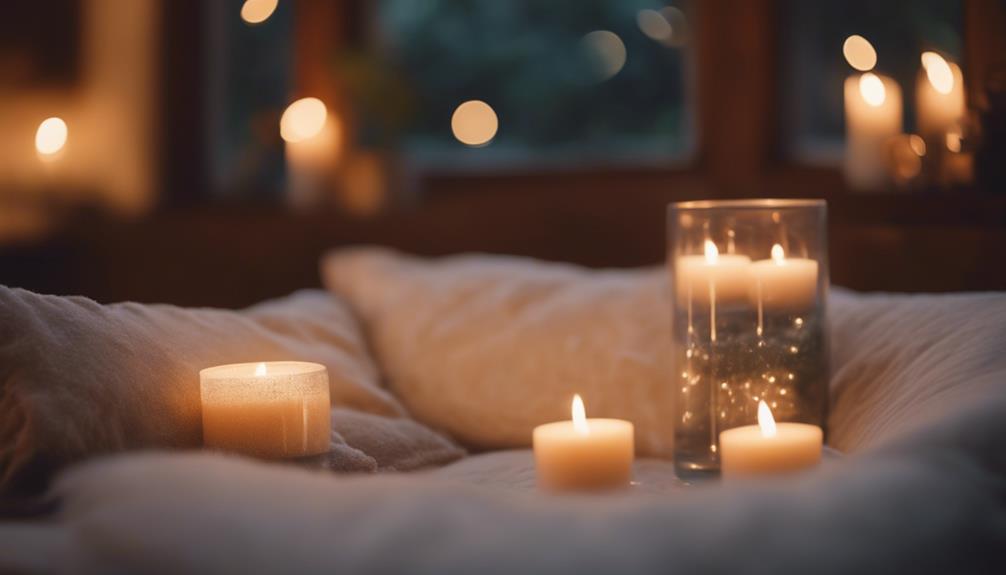
Creating a tranquil home sanctuary also requires careful attention to lighting and sound, as these elements can greatly influence your mood and relaxation levels. You'll want to establish a soothing atmosphere that encourages calmness. Here are some key tips to optimize your space:
- Use soft, warm light with dimmable options to create a relaxing atmosphere.
- Incorporate candles for gentle illumination and soothing scents.
- Implement soundproofing techniques, such as thick curtains and rugs, to minimize distractions.
Experiment with different light colors, like soft blues or warm ambers, to evoke specific emotional responses and personalize your space. This not only creates a calming environment but also allows you to tailor the ambiance to your needs.
Additionally, soundproofing can help block out unwanted noise, making it easier for you to unwind. By focusing on these elements, you'll craft a home sanctuary that promotes relaxation and rejuvenation, allowing you to escape the stresses of daily life.
Transform your space today, and let the soothing light and sound envelop you in peace.
Creating a Relaxation Zone
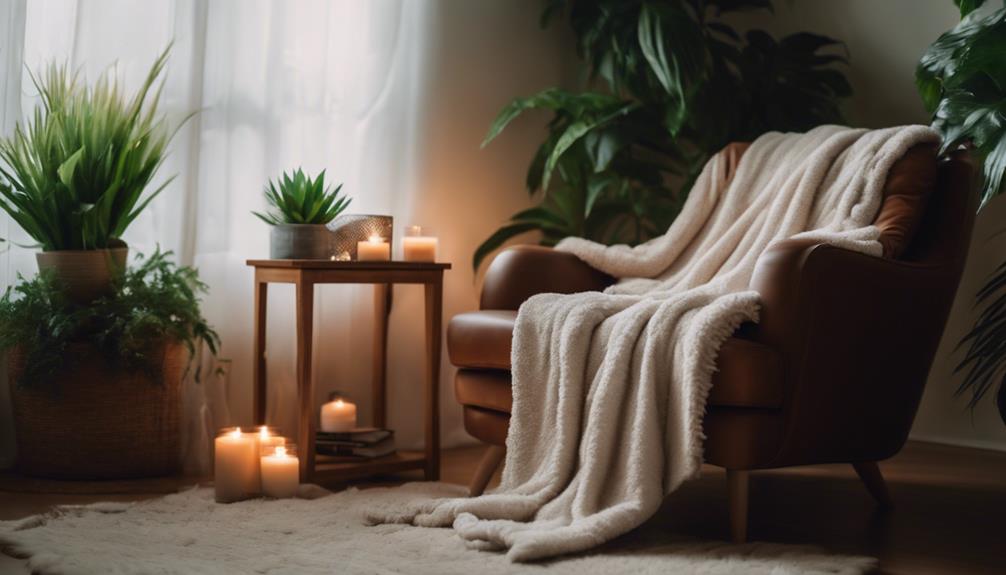
To create an effective relaxation zone, start by designating a quiet space in your home that feels private and calming.
Next, incorporate soothing elements like plants and soft lighting to enhance the atmosphere.
Designate a Quiet Space
Designating a quiet space in your home can transform it into a personal retreat where you can unwind and rejuvenate away from daily distractions. This powerful tool for relaxation allows you to create a cozy environment that feels like a sanctuary.
To set up your tranquil zone effectively, consider these key elements:
- Choose a location with minimal foot traffic to reduce interruptions.
- Maximize natural light to enhance the calming atmosphere and improve your mood.
- Incorporate comfortable seating and soothing decor that resonates with your emotions.
As you establish this space, think about what makes you feel at ease. Add pillows, cozy blankets, or even a favorite piece of art to personalize your quiet area.
Regularly reassess it to guarantee it remains a haven of tranquility, free from distractions. By dedicating a specific spot in your home to relaxation, you'll cultivate a refuge that supports your well-being and mental clarity, making it easier to recharge whenever you need a break from the hustle of daily life.
Incorporate Soothing Elements
Incorporating soothing elements into your relaxation zone invites tranquility and enhances your overall sense of well-being.
To create your personal sanctuary, start by adding houseplants. Not only do they purify the air, but the presence of greenery also reduces stress, making your space feel more natural and calming.
Next, focus on lighting. Use soft, adjustable options like dimmable lamps and candles to establish an ambiance that can shift according to your mood and activities. This gentle lighting is essential for fostering a soothing environment.
Aromatherapy is another powerful tool. Introduce essential oils like lavender and chamomile to fill your space with calming scents that promote relaxation.
Additionally, consider the auditory aspect of your sanctuary. Soft music or nature sounds can considerably lower stress levels, creating a peaceful atmosphere that encourages relaxation.
Establish Relaxation Rituals
Creating a personal relaxation zone goes hand in hand with establishing rituals that promote peace and mindfulness. By dedicating time to these practices, you can transform your space into a sanctuary that nurtures your well-being. Here are a few tips to help you create a home that invites tranquility:
- Set aside specific times each week to meditate or practice deep breathing.
- Use the right lighting to create a warm, inviting atmosphere.
- Limit clutter to foster a sense of calm and focus.
Designate a quiet area in your home where you can spend time uninterrupted. Fill it with comfortable seating, calming colors, and soothing scents like lavender or chamomile.
A no-device policy can also help you minimize distractions, allowing you to fully engage in your relaxation rituals.
Maintaining Your Sanctuary
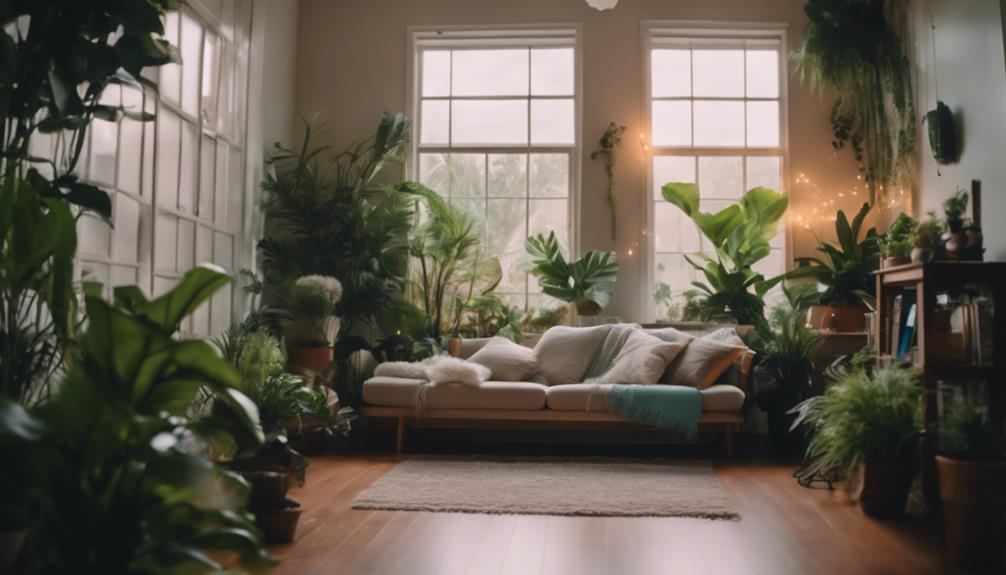
To keep your sanctuary feeling serene and inviting, establish a flexible cleaning routine that balances daily, weekly, and monthly tasks. This approach guarantees maintaining cleanliness without overwhelming your schedule.
Daily tasks, like quick tidying and dishwashing, can help you maintain a clutter-free environment.
Weekly, focus on deeper cleaning, such as dusting surfaces and vacuuming. Don't forget to reassess and declutter your sanctuary regularly. Remove items that no longer bring joy or serve a purpose, promoting a tranquil atmosphere free of distractions.
Implementing a 'no-device' policy in your sanctuary also fosters relaxation and mindfulness. Create designated areas for everything, using baskets or bins for storage, to keep your space organized and accessible.
Additionally, schedule monthly maintenance checks to refresh scents, rearrange decor, or assess your sanctuary's overall vibe. This guarantees your sanctuary continues to feel inviting and personalized over time.
Frequently Asked Questions
How to Create a Sanctuary in Your Home?
To create a sanctuary in your home, start by journaling your preferences. Incorporate natural elements, use calming colors, declutter regularly, and personalize your space with meaningful items to foster relaxation and emotional connections.
What Is a Relaxing Sanctuary?
A relaxing sanctuary is your personal escape from stress. It's a quiet, comfortable space with pleasing visuals, natural elements, and soothing colors. You can practice mindfulness, reflect, and rejuvenate your mind in this serene environment.
What Does My Home Is My Sanctuary Mean?
So, your home's your sanctuary, huh? It means you've got a cozy fortress, a plush retreat where stress can't touch you. It's your personal haven, designed to cradle your soul and nurture your peace.
How Do I Make My Living Room a Sanctuary?
To make your living room a sanctuary, declutter the space, use soft lighting, choose calming colors, add cozy elements like cushions, and introduce natural touches like plants. You'll create a tranquil atmosphere perfect for relaxation.
Conclusion
In creating your relaxing home sanctuary, remember that 'home is where the heart is.'
By personalizing your space and incorporating natural elements, you'll cultivate a haven that rejuvenates your spirit.
Optimize your lighting and sound to enhance tranquility, and don't forget to carve out a dedicated relaxation zone.
With a little maintenance, your sanctuary will be a retreat that nourishes your well-being and invites peace into your everyday life.
Embrace the serenity you deserve!
